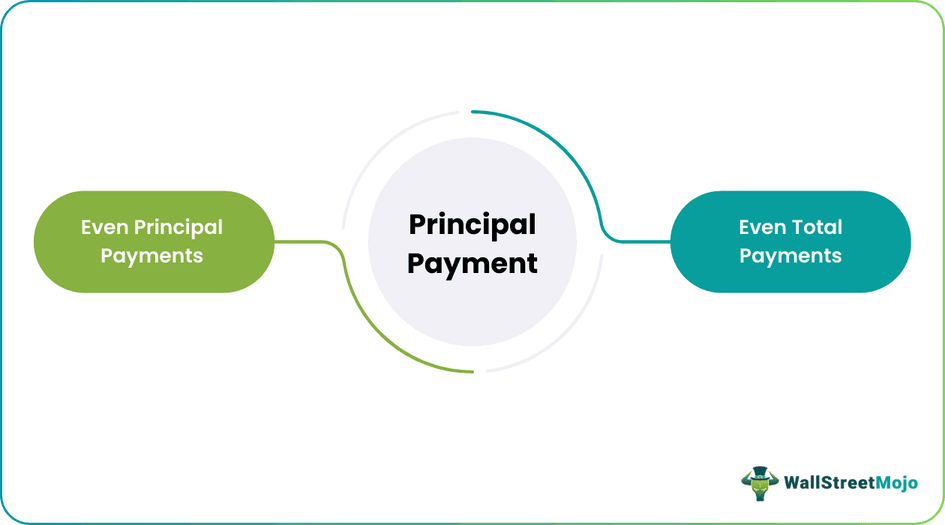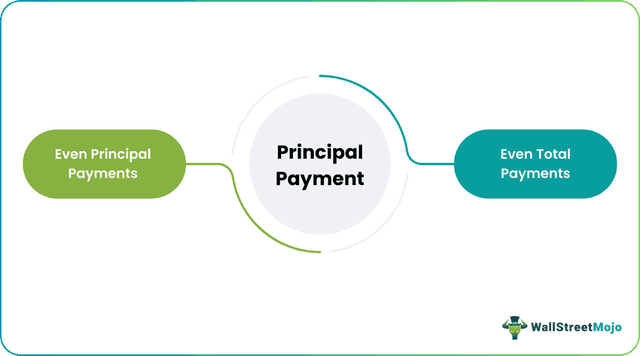Table Of Contents
What is the Principal Payment?
The principal payment is that component of repayment that reduces the amount due to debt outstanding. In finance, a loan, when owed, requires payments to be made via equated installments, which has two components- interest payment (reducing the interest portion due on loan) and principal payment (directly reducing the loan amount due). When a loan is taken, the lender and the borrower mutually decide on the installments that would be made by the borrower at decided intervals. These installments also account for interest or the opportunity cost that the lender forgoes when making the loan.
Types of Principal Payment
There are generally two types of repayment schedules - even principal payments and even total payments.

#1 - Even Principal Payments
In even principal payments, the amount of principal payment is the same for each payment. It is simply computed using the amount of loan originally taken divided by the number of installments. The interest component on such type is the interest charged for the period on the amount outstanding.
#2 - Even Total Payments
In even total payments, the amount of repayment stays the same during the period; however, the interest component decrease while the principal payment size increases. It is important to note that the installment stays the same.
The annual equated repayments, the following formula shall be used:
Equated Installments = P * r *(1+r)n /
Where,
- P =Principal Amount Due
- r = Rate of Interest for Period
- n = Number of Installments
Principal Payment Examples & Calculation
Let’s take an example and understand. Mr. John wants a loan of $100,000 to expand his business and goes to Bank ABC LLC. The Bank decides to lend him the money @2.0% per annum with a tenure of 5 years over which he will repay the loan in 5 installments. Mr. John, depending on the terms of the loan, could make repayments wither by even principal payments or even total payments.
The amortization table in each such case is given below.
Loan Amortization- Even Principal Payments
| Year End | Starting Amount | Repayment | Interest Component | Principal Component | Amount Outstanding |
|---|---|---|---|---|---|
| 1 | $100,000.0 | $22,000.0 | $2,000.0 | $20,000.0 | $80,000.0 |
| 2 | $80,000.0 | $21,600.0 | $1,600.0 | $20,000.0 | $60,000.0 |
| 3 | $60,000.0 | $21,200.0 | $1,200.0 | $20,000.0 | $40,000.0 |
| 4 | $40,000.0 | $20,800.0 | $800.0 | $20,000.0 | $20,000.0 |
| 5 | $20,000.0 | $20,400.0 | $400.0 | $20,000.0 | $0.0 |
The principal payments calculation stays the same, while the interest component changes are based on the amount outstanding.
- Where the payments are based on ‘Even Total Payments,’ we would first need to find equated installments for which we would plug in necessary inputs in the formula above. In the given case P=$100,000 with r =2.0% and n=5.
- When we plug in the inputs in the equation, we get $21,215.8, which is the payment to be made at the end of each year for 5 years. It is important to note here that this payment also includes the interest component, and eventually, what you repay over 5 years would be more than the principal was originally has taken, which is $100,000.
- The table below shows how the amount of outstanding amortizes during the life of the loan. The repayment stays the same during the period with the interest component, reducing with repayment of the principal as per the schedule.
Loan Amortization - Even Total Payments
| Year-End | Starting Amount | Repayment (Equated) | Interest Component | Principal Component | Amount Outstanding |
|---|---|---|---|---|---|
| 1 | $100,000.0 | $21,215.8 | $2,000.0 | $19,215.8 | $80,784.2 |
| 2 | $80,784.2 | $21,215.8 | $1,615.7 | $19,600.2 | $61,184.0 |
| 3 | $61,184.0 | $21,215.8 | $1,223.7 | $19,992.2 | $41,191.8 |
| 4 | $41,191.8 | $21,215.8 | $823.8 | $20,392.0 | $20,799.8 |
| 5 | $20,799.8 | $21,215.8 | $416.0 | $20,799.8 | $0.0 |
Principal Component = Repayment - (Starting Amount * r)
If, at the end of year 2, John decides to repay an extra $20,000 along with the equated payment of $21,215.8, this extra payment will directly reduce the amount outstanding to $41,184.0, and the loan amortization schedule will change.
Loan Amortization - Even Total Payments
| Year-End | Starting Amount | Repayment (Equated) | Interest Component | Principal Component | Amount Outstanding |
|---|---|---|---|---|---|
| 3 | $41,184.0 | $21,215.8 | $823.7 | $20,392.2 | $20,791.8 |
| 4 | $20,791.8 | $21,215.8 | $415.8 | $20,800.0 | ($8.2) |
- In the scenario above, John has been able to repay his loan a year earlier (given he sticks with the same amount of equated payments each year) and has actually saved on interest. In the original case, the interest amount paid during the life of the loan amount was $6,079.2, while in the scenario stated above, the interest amount paid during the life of the loan is $4,855.2, which is lower by $1,244.0
- John provided the loan agreement gives him an option, can also continue the loan for 5 years by restructuring the equated installments at the end of year 2 on principal payment of $20,000.
- The bank would compute the equated installments again for a period of 3 years now on the amount outstanding, which is $41,184.0. The amortization table for this case is given below;
Loan Amortization - Even Total Payments
| Year-End | Starting Amount | Repayment (Equated) | Interest Component | Principal Component | Amount Outstanding |
|---|---|---|---|---|---|
| 1 | $100,000.0 | $21,215.8 | $2,000.0 | $19,215.8 | $80,784.2 |
| 2 | $80,784.2 | $41,215.8 | $1,615.7 | $39,600.2 | $41,184.0 |
| 3 | $41,184.0 | $14,280.7 | $823.7 | $13,457.1 | $27,726.9 |
| 4 | $27,726.9 | $14,280.7 | $554.5 | $13,726.2 | $14,000.7 |
| 5 | $14,000.7 | $14,280.7 | $280.0 | $14,000.7 | ($0.0) |
Advantages of Principal Payment
- Early payment saves interest for the period.
- Reduced debt increases the free cash available to equity shareholders of the company or, in the case of an individual, free cash for himself in the form of saved interest.
- In the case of a company, it leads to a healthy balance sheet on account of reduced debt levels.
- Ideal for cash-rich companies with no further projects to invest in
Disadvantages of Principal Payment
- In cases, the cash used to pay the principal portion can sometimes be used for better alternatives.
- It is important to consider different projects and their NPV before taking a decision on principal repayment, which sometimes could go wrong.
- Sometimes the bank charges a notional fee when the borrower makes a principal repayment.
Conclusion
- Principal payment leads to accelerated repayment of the loan and reduces the amount due. The equated installments have two components- The interest component and Principal component. The principal component is toward the actual amount due, unlike the interest component in which the bank charges the borrower.
- Principal payment has its own pros and cons. It could be advantageous, while at times it could be disadvantageous. It is important that the amount used to pay off liability is not better off being used in a project which earns more than the interest saved. It is very crucial to consider the time value of money while making such decisions.


